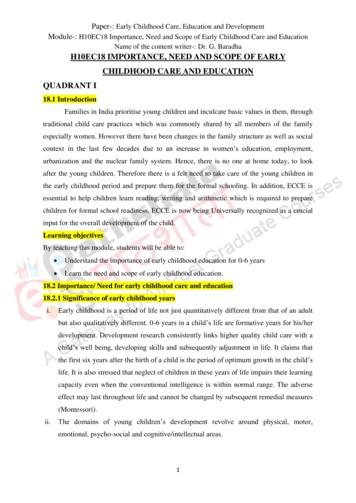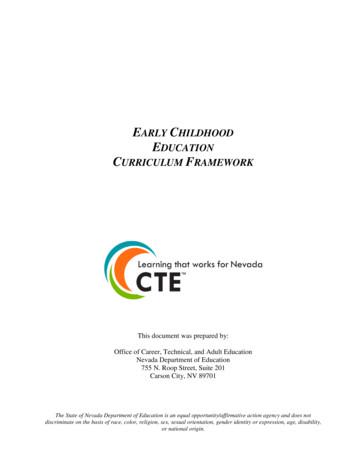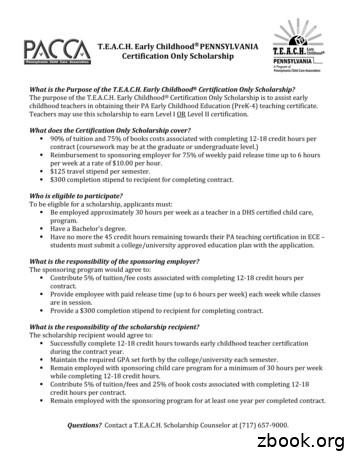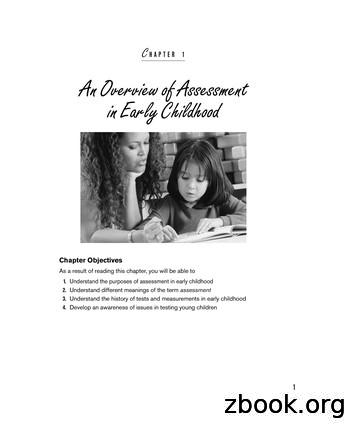CONTEXT OF EARLY CHILDHOOD EDUCATION AND CARE IN IRELAND
CONTEXT OF EARLY CHILDHOOD EDUCATION AND CAREIN IRELANDIn the last decade or so there have been many significant developments in the earlychildhood sector at local, national and European Commission levels.Preschool Regulations were first introduced in Ireland in 1996. These regulationswere revised in 2006 and have now been further revised in the Child Care Act 1991(Early Years Services) Regulations 2016 and the Child Care Act 1991 (Early YearsServices) (Amendment) Regulations 2016. In 2018, Tusla’s Early Years Inspectoratedeveloped the Quality and Regulatory Framework (QRF), which sets out the coreregulatory requirements for compliance with the Early Years Regulations 2016, TheQuality and Regulatory Framework applies to all registered Early Years Services. Itsets out, in a clear way, the requirements for statutory compliance for providers ofservices, the stakeholders and parents/guardians to help them understand how theEarly Years Regulations 2016 are interpreted in practice by the Early YearsInspectorate and how to comply with the Regulations.There have also been some very significant changes in Irish and international laws inrelation to children’s rights. The Early Years Regulations 2016 and these other legalchanges, as well as other important developments, have made a significant impacton what providers of early years care and education services are required to do andwish to do, to meet higher standards of quality in developing and providing safer,more efficient and more effective services for children and families, and to ensurethat children’s rights are protected.The developments and changes have also brought many and varied new supports toearly years providers and educators to help meet these requirements andexpectations.The developments which impact on service provision for young children include: The development of Síolta: The National Quality Framework for EarlyChildhood Education (CECDE, 2006) and the Síolta Quality AssuranceProgramme (QAP). The introduction of Aistear: The Early Childhood Curriculum Framework(NCCA, 2009). Better Outcomes Brighter Futures: The National Policy Framework forChildren & Young People 2014-2020 (DCYA, 2014). The establishment of Tusla, the Child and Family Agency (2014) and thesubsequent nationalisation of the Tusla Early Years InspectorateThe development of the online Aistear Síolta Practice Guide (NCCA, 2015), aquality practice resource which is directly accessible to all providers,educators and parents.1
The introduction of the new Early Years Education Inspectorate (EYEI) at theDepartment of Education and Skills (2015).The creation of the national Better Start Quality Development Service (2015)and AIM the Access and Inclusion Model (2016).The National Síolta Aistear Initiative (2016), which is guided and overseen bya steering group from the Department of Education and Skills (DES), theDepartment of Children and Youth Affairs (DCYA), the National Council forCurriculum and Assessment (NCCA) and Better Start.The coming into operation of the Child Care Act 1991 (Early Years Services)Regulations 2016 and the Child Care Act 1991 (Early Years Services)(Amendment) Regulations 2016 (DCYA, 2016).The requirement under the Early Years Regulations 2016 for services to beregistered with Tusla.The development of the Quality and Regulatory Framework (QRF) 2018 bythe Tusla Early Years Inspectorate.We are awaiting the launch of the first national Early Years Strategy indevelopment by DCYA.All of these positive developments have brought important new understandings,expectations and incentives for service providers to review, evaluate and updatetheir operating processes, policies and procedures.They have also brought many valuable supports for services to inform their policydevelopment and to enhance their practice in all areas.It is important to note that all of these relatively recent developments keep the childat the centre of quality practice and recognise the significance of quality earlychildhood experiences.Awareness of all developments in the early years sector is important whendeveloping policies and procedures and all service policies should reflect all of themost up-to-date developments, knowledge and information.Supports for Early Years Service ProvidersTusla and the Quality and Regulatory FrameworkTusla, the Child and Family Agency was established on the 1st January 2014 and isthe State agency responsible for improving well-being and outcomes for children.The Agency operates under the Child and Family Agency Act 2013, aprogressive piece of legislation with children at its heart, and families viewed asthe foundation of a strong healthy community where children can flourish.2
Partnership and co-operation in the delivery of seamless services to childrenand families are also central to the Act.("About Us Tusla - Child and Family Agency", 2018)Tusla is the regulatory agency responsible for inspecting preschools, play groups,crèches, day-care and similar services which cater for children aged from birth to sixyears.On 4 May 2016, The Minister for Children and Youth Affairs published the Child CareAct 1991 (Early Years Services) Regulations 2016. The Early Years Regulationsprovide for preschool services, that is, those services catering for children under theage of six years who are not attending primary school. The Child Care Act 1991(Early Years Services) (Amendments) Regulations 2016 were published on the 20thDecember 2016. These Regulations are known as the Early Years Regulations2016.Part 12 of The Child and Family Agency Act amends the Child Care Act 1991 (asinserted by section 92 of The Child and Family Agency Act) known as Part VIIA,which sets out the supervision of Early Years Services including inspections andregistration.Tusla National Early Years Inspectorate, is responsible for ensuring that early yearsprovision is delivered in accordance with the Child Care Act 1991 (Early YearsServices) Regulations 2016 and the Child Care Act 1991 (Early Years Services)(Amendment) Regulations 2016.Tusla is also responsible for the registration system of early years service providers,which commenced in 2016. It is a legal requirement for all early years servicesproposing to operate, to make application under section 58D(2) of The Child andFamily Agency Act 2013, at least three months before they intend to commenceoperation (except in the case of a Temporary early years service, in which case atleast 21 days’ notice must be given).A registered provider must operate in accordance with the statutory requirements ofthe State as set down in the Early Years Regulations 2016 and Part 12 of the Childand Family Agency Act 2013 (Article 58 G). Providers have a right of reply to anynon-compliance to the regulations identified on inspection and to registrationdecisions.One of the requirements for registration is to ensure that the policies, proceduresand statements of the service specified in Schedule 5 of the Early Years Regulations2016 are in place.For more information see rlyyears-quality-and-regulatory-framework/3
City/County Childcare Committees (CCCs) and Voluntary ChildcareOrganisations (VCOs)City and County Childcare Committees (CCCs) are funded by the Department ofChildren and Youth Affairs (DCYA) and act as local agents for the DCYA in theadministration of aspects of national early years education and care programmes.The CCCs provide supports to providers with the early years care and educationinitiatives. The CCCs have a local focus and knowledge which is helpful in providingsupports for the development and sustainment of early years services.The CCCs provide: Supports for the delivery of DCYA national programmes; Supports to local service providers and parents on national programmes andservice quality in keeping with national frameworks and policy objectives; Co-ordination and provision of training; and A local centre of advice, information and support for all early years educationand care and school age services related issues.Voluntary Organisations that support Early Years Education and Care Providersinclude: BarnardosEarly Childhood Ireland (ECI)National Childhood Network (NCN)Childminding IrelandGaelscoileanna Teo.Irish Steiner Kindergarten AssociationSt. Nicholas Montessori Society of IrelandCity/County Childcare Committees (CCCs) and the Voluntary Organisations (VCOs)work together locally and nationally to support early years education and careservice providers (and school age service providers) to improve the quality of theirservices. CCCs and VCOs provide this through a variety of mechanisms such asinformation, resources, mentoring, advice and training to service providers. Theypromote and support implementation of the national frameworks that improve thequality of service delivery.Síolta, the National Quality Framework for Early Childhood EducationSíolta, the National Quality Framework for Early Childhood Education was developedby the CECDE (Centre for Early Childhood Development and Education) andpublished in 2006. Its purpose is to provide a national quality framework for all typesof early childhood settings in Ireland and includes a Quality Assurance Programme(QAP). Síolta represents the edited work of a wide range of stakeholders in the4
ECEC sector in Ireland and extensive consultation with the sector played a key rolein its development.Síolta (meaning ‘seeds’ which symbolises the opportunity for growth) comprises 12Principles of quality and 16 Standards of quality which support settings to define,assess and implement quality practice. Síolta is based upon national andinternational research. It addresses all dimensions of practice from providing qualityenvironments for young children’s learning and development, to fostering highquality, positive relationships, to organisation, planning, evaluation and professionalpractice.One of the purposes of Síolta is to act as a tool for policy development and topromote common understandings among those who influence the early experiencesof young children such as those who are engaged in the process of developingpolicies for early years services.Síolta can add value at many levels in practice situations, for example as: a support for individual professional practice and development a focus for team work and team development a tool for management, strategic planning and policy developmentSince December 2008, the Early Years Education Policy Unit of the Department ofEducation and Skills (co-located in the Department of Children and Youth Affairs),has been responsible for the implementation of Síolta.Elements of SíoltaSíolta comprises three main elements as outlined below:1. Principles of Quality – There are 12 Principles and these provide the overallvision of the Framework.2. Standards of Quality – The 16 Standards cover all of the areas of practice thatare addressed and translate the vision of quality contained in the Principlesinto the reality of practice.3. Components of Quality – The Components provide quality indicators forimplementing Síolta. They relate directly to the Standards and act to breakeach standard area of practice down into more focused and specific parts.The Components of Quality are each further explained by a set of Signpostsfor Reflection and ‘Think-abouts’. The Signposts for Reflection act as selfreflection guidelines for early years educators to focus their thinking aboutcurrent practice, and to help identify elements of their practice that arepositive, as well as the elements in need of further development. The ‘Thinkabouts’ support educators in early education settings to become aware of andcritical of their practice.5
The Síolta Standards1. Rights of the ChildEnsuring that each child’s rights are met requires that she or he is enabled toexercise choice and to use initiative as an active participant and partner in heror his own development and learning.2. EnvironmentsEnriching environments, both indoor and outdoor (including materials andequipment) are well-maintained, safe, available, accessible, adaptable,developmentally appropriate, and offer a variety of challenging and stimulatingexperiences.3. Parents and FamiliesValuing and involving parents and families requires a proactive partnershipapproach evidenced by a range of clearly stated, accessible and implementedprocesses, policies and procedures.4. ConsultationEnsuring inclusive decision-making requires consultation that promotesparticipation, and seeks out, listens to and acts upon the views and opinionsof children, parents and staff, and other stakeholders as appropriate.5. InteractionsFostering constructive interactions (child/child, child/adult and adult/adult)requires explicit policies, procedures and practice that emphasise the value ofprocess and are based on mutual respect, equal partnership and sensitivity.6. PlayPromoting play requires that each child has ample time to engage in freelyavailable and accessible, developmentally appropriate and well-resourcedopportunities for exploration, creativity and meaning making in the company ofother children, with participating and supportive adults and alone, whereappropriate.7. CurriculumEncouraging each child’s holistic development and learning requires theimplementation of a verifiable, broad-based, documented and flexiblecurriculum or programme.8. Planning and EvaluationEnriching and informing all aspects of practice within the setting requirescycles of observation, planning, action and evaluation undertaken on a regularbasis.6
9. Health and WelfarePromoting the health and welfare of the child requires protection from harm,provision of nutritious food, appropriate opportunities for rest, and securerelationships characterised by trust and respect.10. OrganisationOrganising and managing resources effectively requires an agreed writtenphilosophy, supported by clearly communicated policies and procedures toguide and determine practice.11. Professional PracticePractising in a professional manner requires that individuals have skills,knowledge, values and attitudes appropriate to their role and responsibilitywithin the setting. In addition, it requires regular reflection upon practice andengagement in supported ongoing professional development.12. CommunicationCommunicating effectively in the best interests of the child requires policies,procedures and actions that promote the proactive sharing of knowledge andinformation among appropriate stakeholders, with respect and confidentiality.13. TransitionsEnsuring continuity of experiences for each child requires policies, proceduresand practice that promote sensitive management of transitions, consistency inkey relationships, liaison within and between settings, the keeping andtransfer of relevant information (with parental consent), and the closeinvolvement of parents and, where appropriate, relevant professionals.14. Identity and BelongingPromoting positive identities and a strong sense of belonging requires clearlydefined policies, procedures and practice that empower every child and adultto develop a confident self- and group-identity, and have a positiveunderstanding and regard for the identity and rights of others.15. Legislation and RegulationBeing compliant requires that all relevant regulations and legislativerequirements are met or exceeded.16. Community InvolvementPromoting community involvement requires the establishment of networks andconnections evidenced by policies, procedures and actions which extend andsupport all adults’ and children’s engagement with the wider community.7
The Síolta PrinciplesThe following are the 12 Principles of Síolta:1. Early childhood is a significant and distinct time in life that must be nurtured,respected, valued and supported in its own right.2. The child’s individuality, strengths, rights and needs are central in theprovision of quality early childhood experiences.3. Parents/guardians are the primary educators of the child and have a preeminent role in promoting her or his well-being, learning and development.4. Responsive, sensitive and reciprocal relationships, which are consistent overtime, are essential to the well-being, learning and development of the youngchild.5. Equality is an essential characteristic of quality early childhood care andeducation.6. Quality early childhood settings acknowledge and respect diversity andensure that all children and families have their individual, personal, culturaland linguistic identity validated.7. The physical environment of the young child has a direct impact on her or hiswell-being, learning and development.8. The safety, welfare and well-being of all children must be protected andpromoted in all early childhood environments.9. The role of the adult in providing quality early childhood experiences isfundamental.10. The provision of quality early childhood experiences requires cooperation,communication and mutual respect.11. Pedagogy1 in early childhood is expressed by curricula or programmes ofactivities which take a holistic approach to the development and learning ofthe child and reflect the inseparable nature of care and education.12. Play is central to the well-being, development and learning of the young child.1Pedagogy is a term that is used to refer to the whole range of interactions which support the child’sdevelopment.8
The Síolta Quality Assurance Programme (QAP)Following the introduction of the Síolta Quality Framework, the Síolta QualityAssurance Programme (QAP) was introduced to allow early years settings to engagein a process of self-assessment and quality development, using the Síolta frameworkin a formal and structured way. The Síolta QAP is a strengths-based approach tousing Síolta that supports early years services to self-assess and develop the qualityof their practice and provision over a period of time.Settings engaging in the QAP work through a series of 10 steps with the support of aSíolta Aistear Mentor as shown in Table 1 below.Table 1 Stages of the Síolta QAPThe Síolta Aistear Mentor’s role is to facilitate the process of implementing the SíoltaQAP by: Providing mentoring support. Encouraging and supporting reflective practice. Supporting settings through the QAP processes – self-assessment, actionplanning, development work and portfolio building (including evidencecollection).Implementing the Síolta Quality Assurance Programme requires a commitment fromearly years teams, but it has many benefits including: Delivering the best possible service to children and families. More effective early learning experiences for children. Seeing familiar things in new ways. Personal and professional development for all team members. A shared understanding within teams and enhanced teamwork. Continuous quality improvement.9
The final stage in the Síolta QAP (Stage C as shown in Table 1) is validation, wherea service’s self-assessed ratings and accompanying portfolio of practice (includingevidence) are reviewed by an external validator. The validator is assigned by theEarly Years Education Policy Unit (EYEPU) at the Department of Education andSkills. A portfolio review, combined with a validation visit to the early years setting,forms part of the validation process. The QAP is completed when a setting is issuedwith a validation certificate by the EYEPU which gives details of the levels of qualitythey have achieved for each of the 16 Síolta Standards.For more information on Síolta and the Síolta QAP see www.siolta.ieAistear, the Early Childhood Curriculum FrameworkAistear, the Early Childhood Curriculum Framework, introduced in 2009, focuses onquality learning experiences in all settings for children aged from birth to six years.Aistear describes the types of learning, the dispositions, values and attitudes, skills,knowledge, and understanding, that are important for children in their early years,and offers ideas and suggestions as to how
Síolta, the National Quality Framework for Early Childhood Education was developed by the CECDE (Centre for Early Childhood Development and Education) and published in 2006. Its purpose is to provide a national quality framework for all types of early childhood settings in Ireland and includes a Quality Assurance Programme (QAP).
Understand the importance of early childhood education for 0-6 years Learn the need and scope of early childhood education. 18.2 Importance/ Need for early childhood care and education 18.2.1 Significance of early childhood years i. Early childhood is a period of life not just quantitatively different from that of an adult
Early Childhood Education I L1 Early Childhood Education II L2 Early Childhood Education III L3C Early Childhood Education Advanced Studies AS The core course sequencing with the complementary courses provided in the following table serves as a guide to schools for their programs of study.
ECE 240 - Administration of Early Childhood Care and Education Programs (3) ECE 241 - Administration: Human Relations for Early Childhood Education (3) Colorado Mesa University B.A. Early Childhood Education - Early Childhood Special Education Advisor: Vail Shoultz-McCole vshoultz@coloradomesa.edu 970-255-2674
Early Childhood Care, Development and Education (ECCDE) is a term that is used interchangeably worldwide but refers to the same concept of early childhood education and cognitive development. The World Bank for instance refers to it as Early Childhood Care and Education, whereas UNESCO refers to it as Early Childhood Development Care.
T.E.A.C.H. Early Childhoodâ PENNSYLVANIA Certification Only Scholarship What is the Purpose of the T.E.A.C.H. Early Childhood Certification Only Scholarship? The purpose of the T.E.A.C.H. Early Childhood Certification Only Scholarship is to assist early childhood teachers in obtaining their PA Early Childhood Education (PreK-4) teaching certificate.
Center-Based and Family Child Care Early Childhood Education Reviewer The Early Childhood Education (ECE) Reviewer must meet one of the following sets of education and experience options: Education and Experience Option I 1. B.A., B.S., or advanced degree in early childhood education/child development or home
CHAPTER 1 An Overview of Assessment in Early Childhood Understanding Assessment in Infancy and Early Childhood Not too long ago, resources on early childhood assessment were limited to occa-sional articles in journals, chapters in textbooks on teaching in early childhood pro-grams, and a few small textbooks that were used as secondary texts in .
The dynamics of group size is an important component of group work. A small group is often considered to consist of three or more people (Beebe & Masterson, 2003). Groups of two are called dyads and are not encouraged for group work because there are not a sufficient number of individuals to generate creativity and a diversity of ideas (Csernica et al., 2002). In general, it is suggested that .























